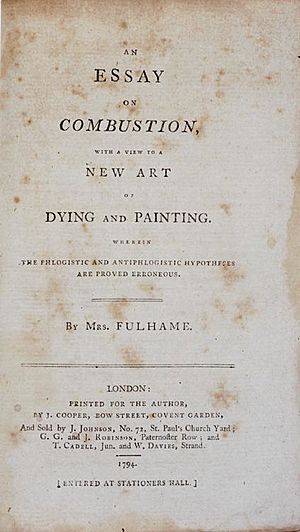Elizabeth Fulhame facts for kids
Quick facts for kids
Elizabeth Fulhame
|
|
|---|---|
| Known for | the concept of catalysis and discovering photoreduction |
| Awards | honorary member of the Philadelphia Chemical Society |
| Scientific career | |
| Fields | chemistry |
| Notes | |
|
|
|
Elizabeth Fulhame was an important early British chemist. She is famous for inventing the idea of catalysis and discovering photoreduction. Catalysis is a process where a substance helps a chemical reaction happen faster without being used up itself. Photoreduction means using light to change chemicals.
In 1794, she wrote a book called An Essay On Combustion. In this book, she explained her many experiments. She looked at how substances react by gaining or losing oxygen. She also shared her ideas about older chemistry theories.
Her book was very popular. It was translated into German in 1798. In 1810, it was published in the United States and received great praise. That same year, she became an honorary member of the Philadelphia Chemical Society. People admired her work, showing that women could also be great scientists.
Contents
About Elizabeth Fulhame
Elizabeth Fulhame published her scientific work using her married name, Mrs. Fulhame. She was married to Thomas Fulhame, a doctor from Ireland. He had studied medicine in Edinburgh, Scotland.
Some people think Elizabeth Fulhame was Scottish. However, this idea mainly comes from her husband studying in Edinburgh. There isn't much other proof. A famous scientist, Sir Benjamin Thompson, called her "the ingenious and lively Mrs. Fulhame." This might have been because her book was written in a very engaging way.
Elizabeth Fulhame's Discoveries
Mrs. Fulhame's scientific journey began with a special interest. She wanted to find ways to color cloth using heavy metals and light. She first thought about naming her book An Essay on the Art of making Cloths of Gold, Silver, and other Metals. But she decided on a broader title because her experiments had wider importance.
She wrote: "The possibility of making cloths of gold, silver, and other metals, by chymical processes, occurred to me in the year 1780... However, after some time, I had the satisfaction of realizing the idea, in some degree, by experiment."
She spent 14 years doing research. In 1793, she met Sir Joseph Priestley, who encouraged her to publish her findings.
Experiments with Metals
Fulhame studied how metallic salts could be changed into pure metals. She did experiments using different forms of these salts, like:
- In water solutions
- In a dry state
- Sometimes in alcohol solutions
She then exposed these salts to various substances that could cause a chemical change. These substances included hydrogen gas, phosphorus, and even light. She worked with salts of gold, silver, platinum, mercury, copper, and tin. Through her work, she discovered many new chemical reactions. These reactions could turn metal salts into pure metals.
One of her most important discoveries was that metals could be processed using chemicals in water at room temperature. Before this, metals were usually melted at very high temperatures.
Understanding Catalysis
Her ideas about catalysis were a huge step forward in chemistry. She showed that many reactions where substances gain oxygen only happen when water is present. She also proved that water is directly involved in these reactions. Even better, the water is returned at the end of the reaction, ready to be used again.
She also suggested modern ways that these reactions happen. She might have been the first scientist to do this. Her ideas about the role of oxygen were different from other theories at the time. Her research helped set the stage for later chemists.
Early Photography Work
Elizabeth Fulhame's work on silver chemistry was also very important for the start of photography. She studied how light-sensitive chemicals, like silver salts, reacted on fabric. Her work came before Thomas Wedgwood's famous photography experiments in 1801.
While Fulhame didn't try to make "images" or shadow pictures like Wedgwood, she did use light to change chemicals. This process is called photoreduction.
See also
 In Spanish: Elizabeth Fullhame para niños
In Spanish: Elizabeth Fullhame para niños


